Philippines is an island country in the southwest Pacific Ocean. Its official name is Republic of the Philippines. The Philippines consists of more than 7,000 islands, but only about 1,000 of them are inhabited. The 11 largest islands make up more than 95 percent of the country’s area. Manila is the capital of the Philippines and the nation’s busiest port. Quezon City is the nation’s largest city.
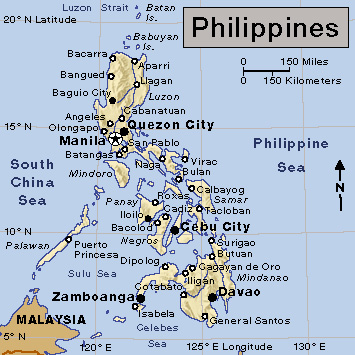
The people of the Philippines are called Filipinos. Their ancestors came from mainland Southeast Asia and, later, from what are today Indonesia and Malaysia. Early settlers formed small communities throughout the islands, and these groups developed their own cultures as they interacted with one another and with other groups in Southeast Asia. As a result, the Philippines has a wide variety of languages, customs, and ways of life.
The country has many fine bays and harbors. Volcanoes, many of which are active, rise on most of the larger islands. Mountain ranges also cut across the country’s major islands. Earthquakes occur frequently.
Service industries employ a majority of Philippine workers. Many other people work in construction, fishing, forestry, manufacturing, and mining. Philippine farmers produce most of the food the people need. However, as the country’s economy becomes more diversified, agriculture is decreasing in importance.
Spanish explorers colonized the Philippines in the 1500’s. They named the islands after King Philip II of Spain. Roman Catholic missionaries converted most of the Filipinos to Christianity. However, they failed to convert Muslims on the southern island of Mindanao and Indigenous (native) communities in the mountains of the northern island of Luzon. Today, the Philippines has more Christians than any other nation of Asia.
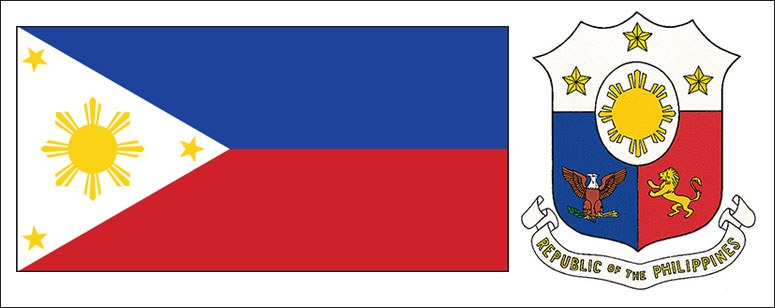
In 1898, Spain sold the Philippines to the United States as part of the treaty that ended the Spanish-American War. The Philippines became independent of the United States on July 4, 1946.
For information on the government of the Philippines, see Philippines, Government of the. For information on history, see Philippines, History of the.
The people
Ancestry.
Almost all Filipinos are related to the Malays of Indonesia and Malaysia. People with full or partial Chinese ancestry make up the second largest group in the Philippines. Smaller numbers of people from Europe, India, Japan, and the United States also live on the islands. All of these groups have contributed to Philippine culture, a blend of Asian and Western traditions.
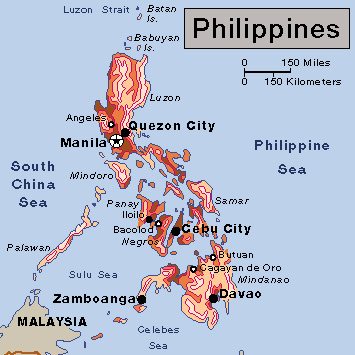
Small groups of Filipinos live in isolated mountain areas. These small groups include the Negritos, Indigenous people whose ancestors settled on the islands about 30,000 years ago.
Languages.
The Philippines has two official languages, Filipino (also spelled Pilipino) and English. Filipino is the national language, and it is a required subject in all Philippine elementary schools. Filipino developed mainly from Tagalog << tah GAH lohg or tah GAH log >>, the language of the people of Manila and the provinces surrounding it. More than half the people of the Philippines speak Filipino, and a large number also use Tagalog. About 70 other languages, all of them related to Malay languages, are also spoken in the Philippines.
Almost three-fourths of the people in the Philippines speak some English. In many classes in elementary and high schools, English is used in combination with Filipino. In elementary schools, the students’ native languages also are used to aid in teaching. Universities require students to pass an English examination when applying for admission. English is also widely used in commerce and government. A relatively small number of Filipinos speak Spanish or Chinese.
Way of life.
About 25 percent of the Philippine workers make their living by farming. Much of the farmland is divided into large and medium-sized farms. The owners hire laborers who live and work on the land. Large numbers of people also have jobs in the fishing, lumbering, and mining industries. In the cities, many people work in factories or in the service sector.
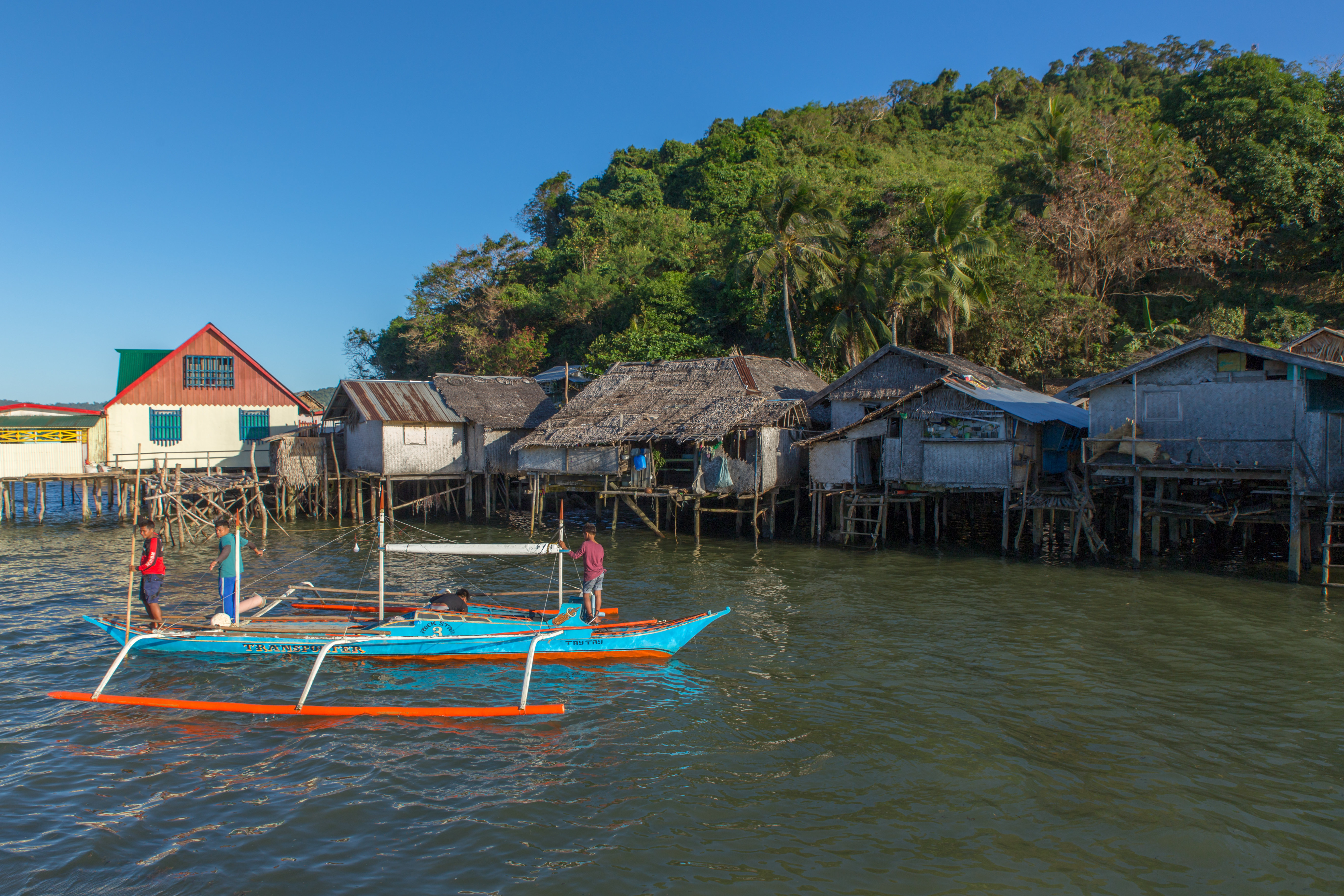

Most houses in rural areas stand close together in small clusters. They have wooden walls, and roofs made of thatch or corrugated iron. Rural families with income from relatives working abroad can afford to improve upon such homes or build new, sturdier ones. Wealthy families in cities live in large houses surrounded by walls.
Government-built housing projects are common in the cities. However, many poor urban people live in roughly constructed shacks in sprawling slums.
Most Filipinos have large families and maintain a close relationship with all family members, including elderly relatives and distant cousins. Men hold most positions of authority at home and in business. However, women are more dominant in some families. Many upper- and middle-class women work in professional fields. A growing number of poor urban women work in textile or electronics factories.
Philippine food is a mixture of American, Chinese, Malay, and Spanish dishes. Most Filipinos eat rice at every meal, with beef, fish, or poultry, if they can afford meat. Each region has its own specialties. The most popular dish is adobo, made of chicken and pork marinated and then cooked in bay leaf, pepper, soy sauce, and vinegar. People throughout the islands drink tuba, an alcoholic beverage made from the sap of the coconut palm tree. San Miguel Beer, a kind of beer from the Philippines, is also popular.
Most Filipinos wear clothes like those worn in most Western countries. On holidays and other special occasions, Philippine men wear a barong tagalog, a beautifully embroidered shirt made of cotton, pineapple fiber, or raw silk. Some men wear the barong tagalog to work in offices. Women may wear a long, puff-sleeved dress called a balintawak on special occasions.
Basketball is the most popular sport in the Philippines. Billiards, boxing, and soccer are also extremely popular. Other favorite sports include baseball and, among the wealthy, golf. Karaoke (singing along to recorded music) is a favorite form of entertainment in the Philippines. Many Filipinos also enjoy gambling, much of which is legal in the country.
Religion.
The Philippine Constitution guarantees freedom of worship. About 90 percent of the people are Christians, more than in any other Asian country. About 80 percent of the people are Roman Catholics. Other Christians include Protestants, and members of the Philippine Independent Church and the Iglesia ni Cristo (Church of Christ). The nation also has many Muslims.
Education.
Nearly all Philippine adults can read and write. The law requires children from 5 to 17 years old to go to school, from kindergarten through the 12th grade. Teachers in the public elementary schools conduct classes in the students’ native language for the first few years and then introduce English and Filipino. Most of the private schools teach in English. The high schools and universities mostly use English. 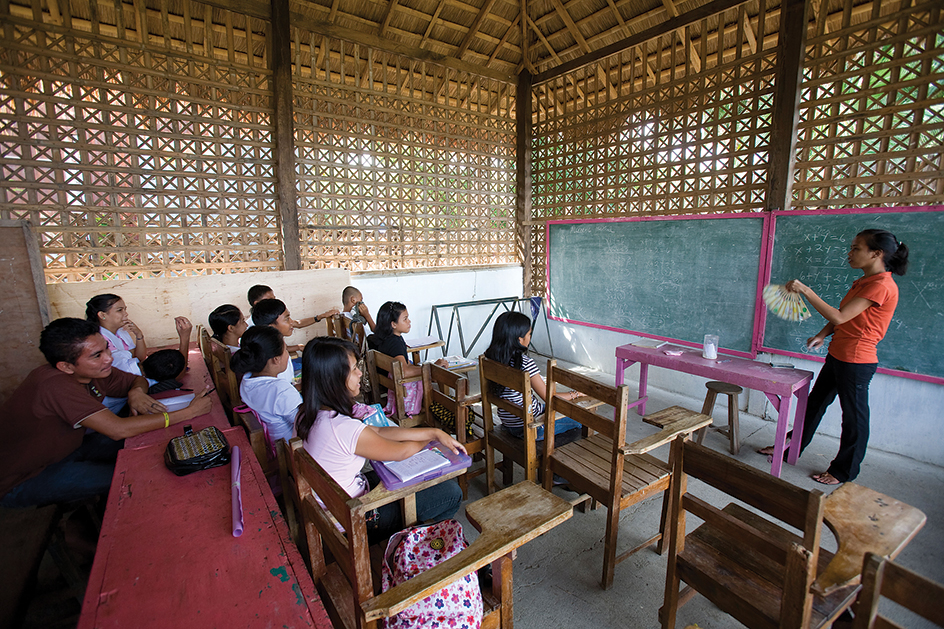
Many Filipinos attend colleges and universities after high school. Most go to private or religious institutions. Others attend the country’s more than 100 public schools. The University of the East, a private institution in Manila, is the nation’s largest university. The University of the Philippines, a public institution founded in 1908, is considered the country’s national university.
The arts.
The Philippines has produced many painters and writers. Fabian de la Rosa, a popular Philippine artist of the 1800’s, painted works showing the everyday life of the people. Fernando Amorsolo, who studied under de la Rosa, became known in the 1900’s for his portraits and rural landscapes. Benedicto Cabrera, also known as BenCab, became a famous painter of the late 1900’s and early 2000’s. He is known for his figurative painting.
Early Philippine literature consisted mainly of legends and poems. During the late 1800’s, Philippine writers began examining Filipinos’ heritage. Literature played an important part in the Philippine movement for independence in the late 1800’s and early 1900’s. José Rizal, an early leader of the movement, wrote novels that criticized Spanish authority in the Philippines. The works of Renato Constantino, Nick Joaquin, and Resil B. Mojares, writers of the mid-1900’s to the early 2000’s, center on modern Filipinos and their search for a national identity.
Land and climate
Thick forests once covered most of the Philippines. But since the 1950’s, extensive lumbering has destroyed much of the forests. Narrow strips of lowland lie along the coasts of the islands. The islands of Luzon and Panay have wide inland plains. Volcanic mountains rise on most of the country’s larger islands, and many of the volcanoes are active. The highest mountain, Mount Apo on Mindanao, towers 9,692 feet (2,954 meters) above sea level. Violent earthquakes occur frequently in the Philippines.
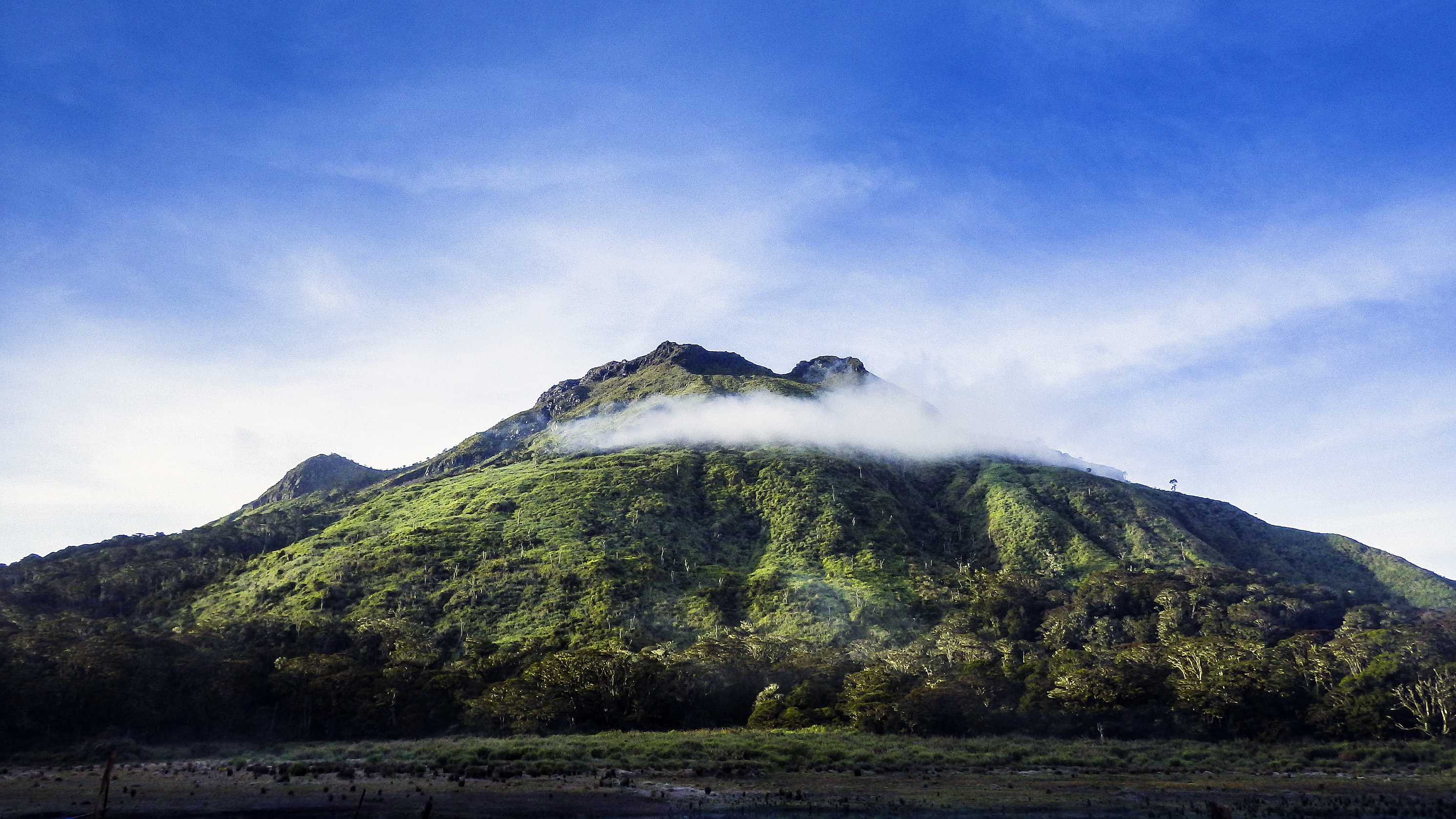
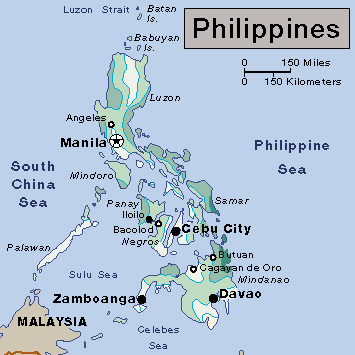

The Philippines has many fine bays and harbors. Large lakes include Laguna de Bay on Luzon and Lake Lanao on Mindanao. Most of the rivers flow only in the rainy season, from June to February. The Philippine Trench, one of the deepest points in all the oceans, is off the northeast coast of Mindanao. It is 34,578 feet (10,539 meters) below the surface of the Pacific.
A wide variety of plants and animals live in the Philippines. Banyan and palm trees grow in the forests. Thick groves of bamboo and about 9,000 other kinds of flowering plants grow throughout the islands. In addition, large areas of mangrove trees protect the shorelines from erosion and storm waves. Wild animals of the Philippines include crocodiles, monkeys, snakes, and many species of tropical birds. Tarsiers, small mammals with owllike eyes, live only in the central Philippines and on some other islands in Southeast Asia. The chief domestic animal in the Philippines is the carabao, a type of water buffalo that farmers use to pull plows and do other heavy work.
The main islands.
The Philippine Islands extend 1,152 miles (1,854 kilometers) from north to south and 688 miles (1,107 kilometers) from east to west. Most of the islands form three groups. The northern group consists mainly of two large islands, Luzon and Mindoro. The central group, called the Visayan Islands, is made up of about 7,000 islands. The southern group consists of Mindanao and the Sulu Archipelago, a group of about 400 islands that extend south and west toward Borneo. This section describes the 11 largest islands of the Philippines. The islands are listed in order of size.
Luzon << loo ZON >> (area 40,420 mi2, or 104,688 km2), in the northern group, is the most important island. Manila lies on the southwest coast. Luzon produces most of the nation’s rice and tobacco. It also has large deposits of copper, gold, and other minerals.
Mindanao << `mihn` dah NOW or `mihn` dah NAH oh >> (area 36,537 mi2, or 94,630 km2) lies at the southeastern end of the Philippines. The country’s highest mountains, including some active volcanoes, are on this island. The Celebes Sea, south of Mindanao, is rich in a variety of marine life. Mindanao is one of the world’s leading producers of bananas and pineapples for export. Industrial development has caused serious ecological problems on the island.
Samar << SAH mahr >> (area 5,050 mi2, or 13,080 km2) lies in the Visayas. Farmers on the island grow abacá, a plant grown for its fibers; coconuts; corn; and rice. Industrial development has also caused ecological problems on Samar. Many of the forests have been cut back, and copper mining and manufacturing have polluted the rivers and streams.
Negros << NEH grohs or NAY grohs >> (area 4,905 mi2, or 12,705 km2), in the Visayas, produces sugar and tobacco. Volcanic lava helps fertilize the soil.
Palawan << pah LAH wahn >> (area 4,550 mi2, or 11,785 km2) lies west of the Visayas. Much of Palawan consists of forest-covered hills. But the forests have been rapidly reduced by legal and illegal logging. The people on Palawan raise corn, rice, and vegetables on hillside farms. Palawan’s coves and small bays attract many tourists.
Panay << pah NY >> (area 4,446 mi2, or 11,515 km2), in the Visayas, produces coconuts and sugar cane. The Iloilo Plain, in southeastern Panay, is one of the country’s most fertile, thickly populated areas.
Mindoro << mihn DOHR oh >> (area 3,759 mi2, or 9,735 km2) is in the northern group. Mindoro produces coconuts, rice, and Philippine mahogany.
Leyte << LAY teh or LAY tee >> (area 2,785 mi2, or 7,214 km2), in the Visayas, became famous during World War II. It was the scene of the first landing of U.S. troops when they recaptured the Philippines from the Japanese in 1944 and 1945. Farms on Leyte produce abacá, coconuts, and rice.
Cebu << seh BOO or say BOO >> (area 1,707 mi2, or 4,422 km2), in the Visayas, is the most densely populated island. It produces coconuts, corn, rice, sugar cane, and tobacco. Cebu’s chief city, Cebu City, is a busy port.
Bohol << boh HAWL >> (area 1,492 mi2, or 3,865 km2) lies in the Visayas. The people on this thickly populated island raise abacá, coconuts, corn, and rice.
Masbate << mahs BAH teh or mahs BAH tuh >> (area 1,262 mi2, or 3,269 km2) is sometimes classified with the northern group, and sometimes classified with the Visayas. It is a chief gold-mining area. Scattered farmlands on the island produce coconuts, corn, rice, and sugar cane.
Climate.
The Philippines has a hot, humid climate. During the hottest months, from March to May, temperatures may reach 100 °F (38 °C). The weather cools off during the rainy season, which lasts from June to February, but the temperature seldom falls below 70 °F (21 °C). Manila has an average temperature of 75 °F (24 °C) in January and 82 °F (28 °C) in May. 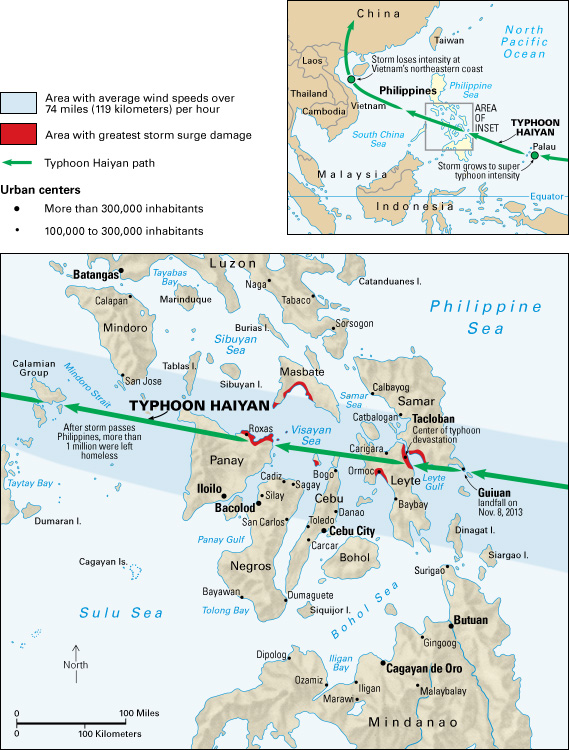
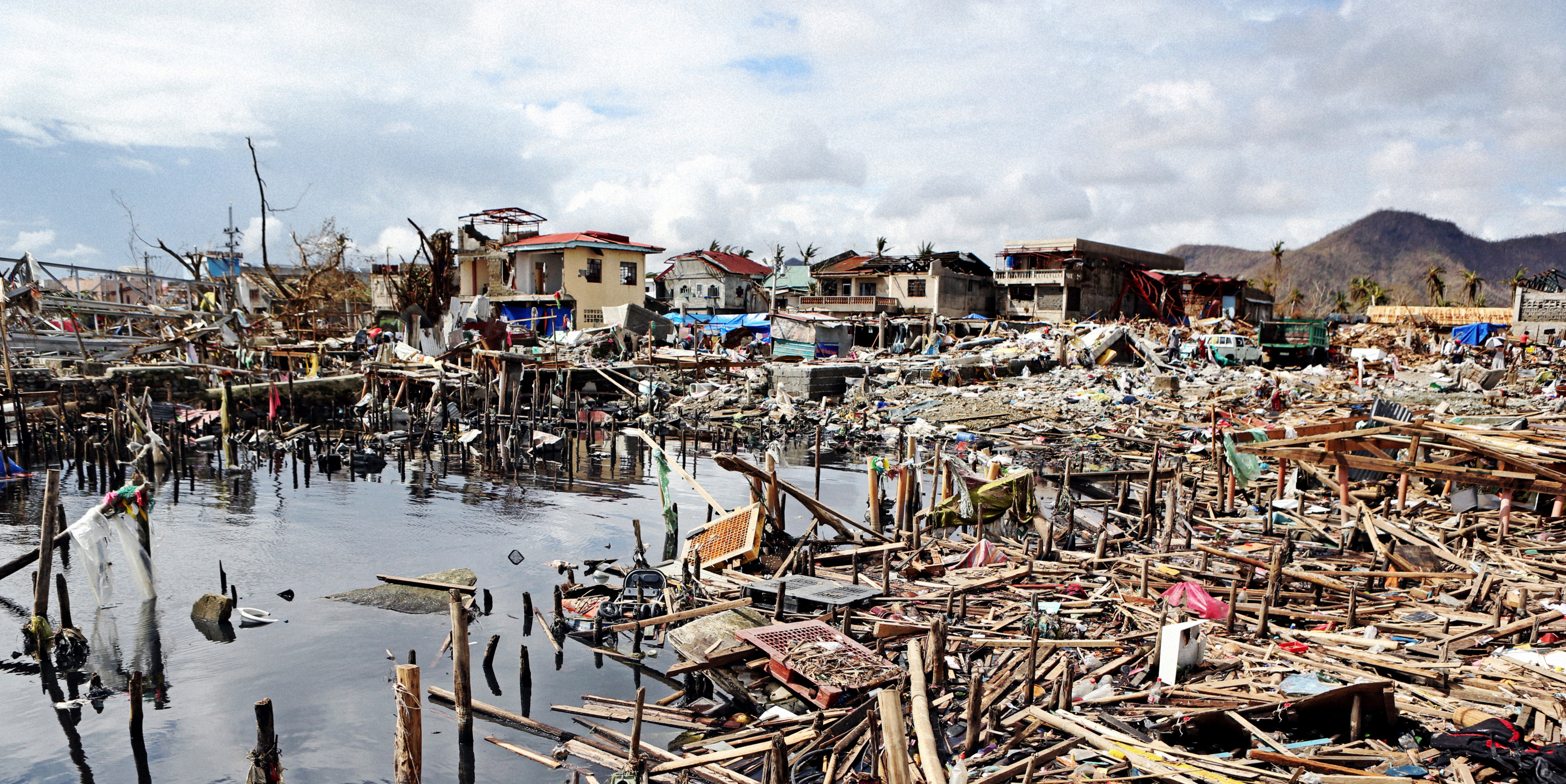
Rainfall in the Philippines averages 100 inches (250 centimeters) a year, with some areas receiving up to 180 inches (457 centimeters). The lowlands have less rain than the uplands because the mountains block winds that carry rain-bearing clouds from the ocean. About five typhoons strike the Philippines yearly, causing property damage and loss of life.
Economy
The Philippines has a developing economy. The nation possesses abundant natural resources. However, unemployment and underemployment are persistent problems, and many Filipinos live below the poverty line.
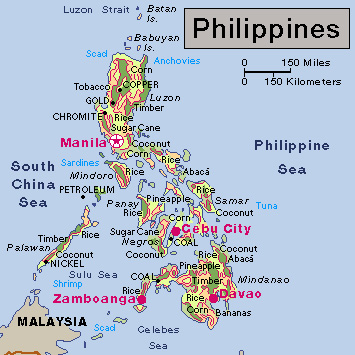
Many Philippine workers make their living in agriculture, forestry, or fishing. Over half work in service industries, which include education, government, medicine, trade, transportation, communication, and financial services. A growing number of people work in manufacturing, construction, and mining. In addition, millions of Filipinos work in other countries and send part of their earnings back home.
Agriculture.
Crops grow on only about one-third of the nation’s land. But the country’s farmers produce most of the food for the entire population. Most farms in the islands lie on lowlands, but farmers also raise crops on hillsides and mountain slopes. 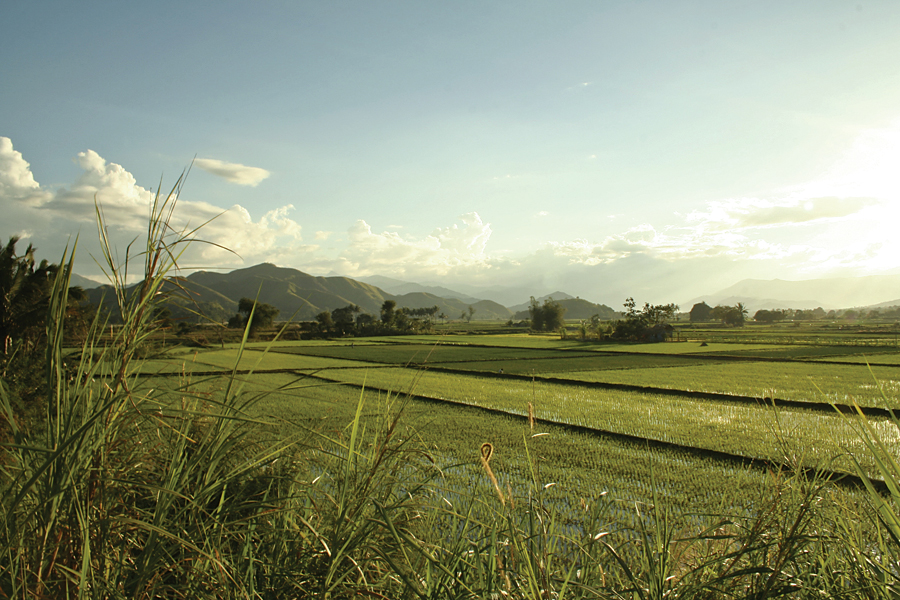
Rice is the leading food crop of the Philippines. However, the country is also a leading importer of rice. Other leading food crops include cassava (a starchy root) and corn. Bananas, coconuts, mangoes, pineapples, and sugar cane are raised for local use and for export. The Philippines is one of the world’s leading producers of bananas, coconuts, and pineapples. Farmers also raise buffaloes, cattle, chickens, and hogs. The country is the world’s leading grower of abacá, a plant used in making rope.
Forestry.
Forests cover about one-fourth of the land in the Philippines. More than 3,000 kinds of trees grow on the islands. Most of the lumber comes from several related kinds of trees called Philippine mahoganies. Mangroves and pines also yield lumber. The kapok tree produces a fiber, also called kapok, used in making insulation, mattresses, and upholstery. Bamboo grows throughout the islands. Filipinos use the stiff, hollow stems of this plant in building houses and in making furniture, handicrafts, and other items.
Mining.
Minerals from rich deposits make up a large part of the Philippines’ exports. Copper is mined on Cebu and Luzon. Large gold mines operate on Luzon. The Philippines is a leading world producer of nickel. The country also mines chromite, coal, cobalt, lead, limestone, and silver.
Fishing industry.
Fishing crews catch anchovies, mackerel, sardines, scad, tuna, and other fishes in the waters surrounding the Philippines. Crabs and shrimp also live in the islands’ waters. Near the southern islands, divers gather sponges and certain shellfish, including clams and oysters, from which mother-of-pearl is obtained. Milkfish, shrimp, and tilapia are raised in ponds built along the ocean shores and near the mouths of rivers.
Manufacturing.
The principal industries of the Philippines produce chemicals, clothing, foods and beverages, motor vehicles, refined metals and petroleum, and semiconductors and other electronic products. Many companies operate in free trade zones, where businesses can import foreign goods without paying import taxes. Factories in these areas produce electronic equipment and other items.
International trade.
The Philippines cannot produce everything it needs, and so it depends heavily on international trade. The country imports more than it exports. The nation’s chief imports include electronics, food, machinery, petroleum and petroleum products, and transportation equipment. The Philippines exports electronics and electronic equipment, food, machinery, mined products, and transportation equipment. The country mainly trades with China, Indonesia, Japan, Singapore, South Korea, Thailand, and the United States. 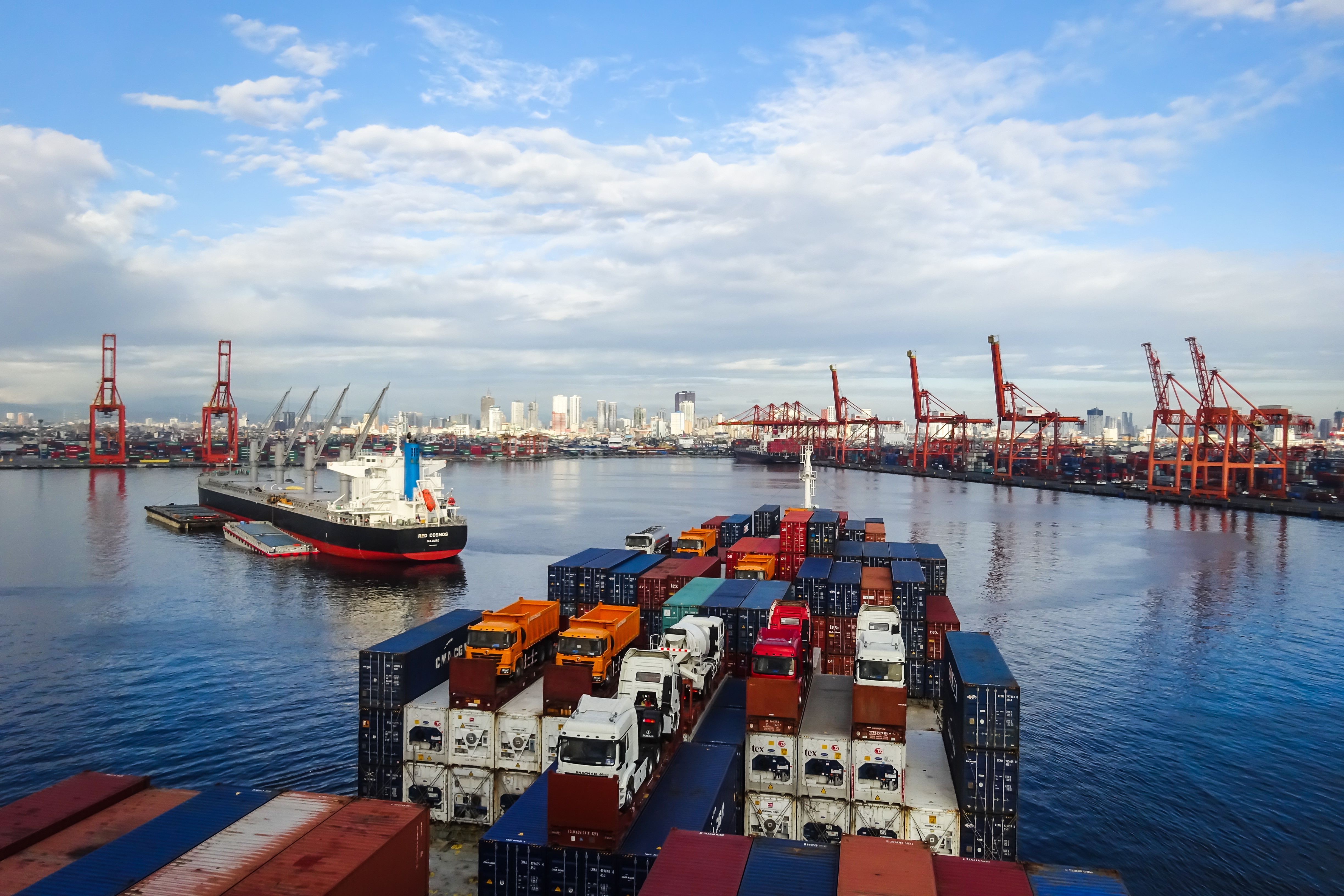
Transportation.
The Philippines has an extensive network of roads. However, many of the roads are in poor condition. In most cities, brightly decorated converted jeeps called jeepneys provide public transportation alongside taxis and buses. But they face competition from private ride-sharing services. Many Filipinos own a motorcycle or motorized tricycle. A relatively small number of people own a car, jeepney, or van. The nation’s railroads operate largely on Luzon. The Manila metropolitan area has an elevated light rail system. However, traffic jams overburden the current road and rail systems.
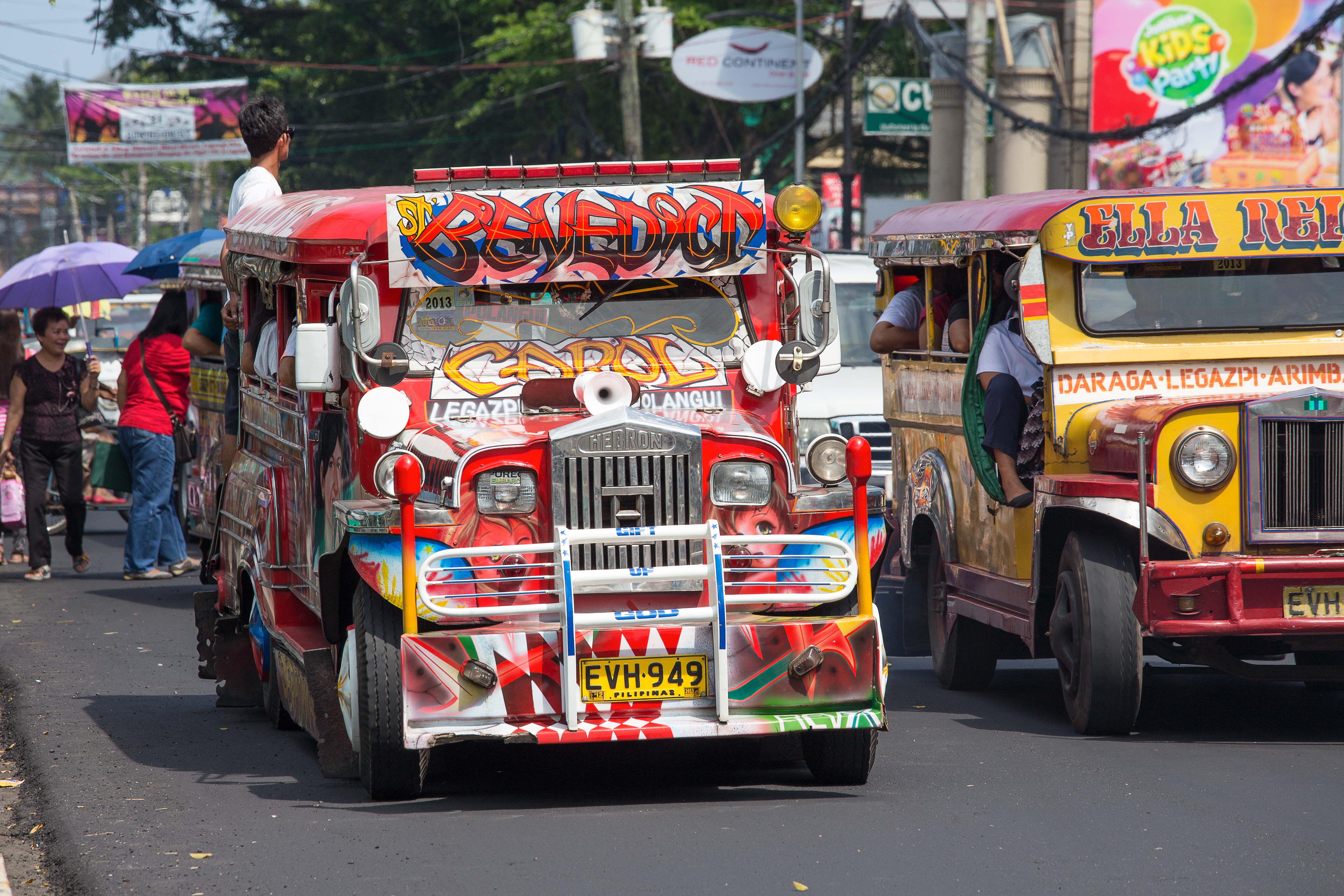
Ships and airplanes carry passengers and cargo from one island to another. Manila is the country’s busiest port. Other leading ports include Cebu City and Davao. Manila has the country’s main international airport. Other international airports serve Cebu City and Davao.
Communication.
The Philippines has many newspapers. Most are published in English, and some are published in Filipino, Chinese, or other languages. Among the largest newspapers are the Manila Bulletin, The Manila Times, the Philippine Daily Inquirer, and the Philippine Star. Most Filipinos access the online editions of these newspapers. Radio and television stations in the Philippines operate under both private and state ownership.
